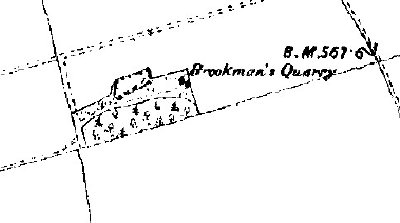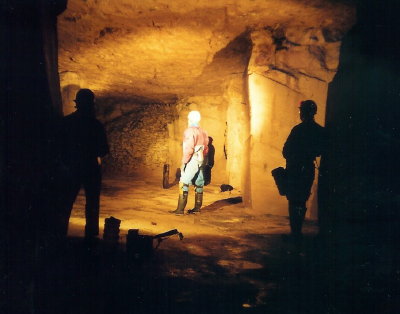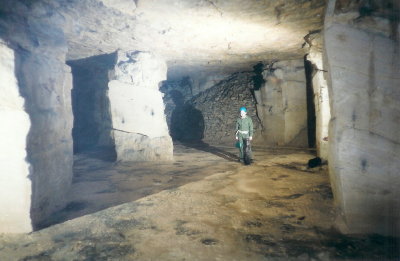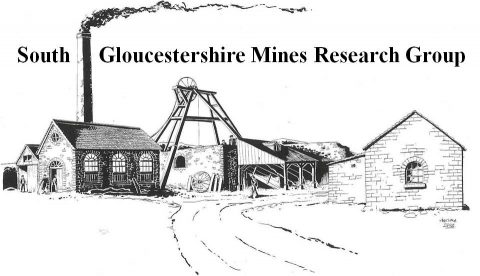Brookman’s Quarry, Tormarton
By David Pollard
Bath stone, or freestone, meaning free working stone, is a Jurassic age oolitic limestone used for building purposes. It was, and still is quarried around Bath in north Somerset and Wiltshire, it was also dug on a much smaller scale along the eastern fringe of South Gloucestershire. Dug by both surface and underground workings, underground quarries were classified as mines under the Metalliferous Mines Act of 1872 and subsequent Acts, it is a legal definition. Here they are referred to as quarries, which is what they have always been known as. In South Gloucestershire the Bath Stone beds are at shallow depth and were mainly worked on the Badminton Estate in Tormarton and Old Sodbury parishes to supply a very local market.
The earliest known reference to quarrying in Tormarton is 4th March 1793 when James Gingell was killed “in consequence of a certain quantity of Earth & Rubbish falling upon his Body as he was raising Stone in a certain Quarry in the Parish of Tormarton”.
Brookman’s Quarry in Tormarton is an underground one, it is pencilled on a map of the Manor of Tormarton dated 1763, and is thus of later date. Thomas Brookman a farmer worked it up to 1863, from 1864 it appears to have been worked by the Badminton Estate, digging continued up to 1916 when the quarry closed. In the summer of 1936 the Bath & Portland Stone Firms Ltd sunk a shaft in the floor of the quarry in order to test the nature of the stone at a greater depth, the Badminton Estate paid £25 towards the cost. The work was done by Owen Bishop, a well known Corsham ganger. The gang included Ted Gibbons of Gastard who died in the early 1990s, he was the last man to work underground at Tormarton.



Tormarton stone was used for the restoration of Acton Turville Church in 1853, for the new font and the pillars and arches which separate the Aisles from the Nave and the corbels supporting the roof. A new font was supplied to West Littleton church in 1856.
The quarry is basically an inclined roadway type where the hauling road descends from the surface down to the floor of the quarry where the head of stone was undermined by pillar and stall workings. The freestone is wedge bedded i.e. the strata is inclined, unique features include the remains of a very early loading crane and mixed gauge wagon ruts. The square 1936 trial shaft is still there.
NB – These Quarries are NOT open to the Public.
Tormarton Quarrymasters & Quarrymen
| Census | Name | Age | Occupation | Birth Place |
|---|---|---|---|---|
| 1841 | Thomas Blackmore | 40 | Stone Mason | |
| 1841 | Thomas Brookman | 50? | Farmer | |
| 1841 | Robert Gay | 29 | Stone Mason | Glos |
| 1851 | Thomas Blackmore | 45? | Quarryman | Wilts., Hullavington |
| 1851 | Thomas Brookman | 67 | Farmer & Quarrymaster | Wilts., West Kington |
| 1851 | Joseph Knee | 19 | Freestone Lab | Tormarton |
| 1861 | Thomas Brookman | 77 | (Quarryman) Master-employing 4 Men | Wilt., West Kington |
| 1861 | Robert Gay | 50 | Underground Quarrier | Pucklechurch |
| 1881 | William Silverthorne | 53 | StoneQuarry Lab | Tormarton |
| 1891 | Stephen Strange | 46 | Lab Stone Quarry Miner | Tormarton |
| 1901 | Stephen Strange | Soft Stone Labourer | Tormarton | |
Lists of Men Employed
| Year | No. of Men Below Ground | No. of Men Above Ground | Notes |
|---|---|---|---|
| 1894 | |||
| 1895 | Worked occasionally for private use only | ||
| 1898 | 2 | ||
| 1899 | 2 | ||
| 1900 | 1 | 1 | |
| 1901 | 1 | 2 | |
| 1902 | 1 | 2 | |
| 1903 | 2 | 1 | |
| 1904 | 3 | 0 | |
| 1905 | 2 | 1 | Duke of Beaufort c/o Cowper Coles |
| 1906 | 3 | ||
| 1907 | 2 | ||
| 1908 | 2 | ||
| 1909 | 2 | ||
| 1910 | 2 | ||
| 1911 | 2 | 2 | Duke of Beaufort c/o Wilfred Markham Badmington |
| 1912 | 2 | 2 | |
| 1915 | 2 | 2 | |
| 1921 | Not listed | ||
Mineral Statistics
Production Year:
- 1885 – None
- 1887 – 74 Tons
Cross Hands Quarry (aka Eyles’ or Turner’s Quarry)
By David Pollard
The history and remains of the freestone quarries in Old Sodbury parish are less well defined than at Tormarton. The Old Sodbury Tithe Map & Apportionment of circa 1840 mentions quarries on Upper Down and in North Field, also some pasture land named Shaft Croft but gives no clue as to who was actually working these quarries.
In February 1853 it was reported that the dressings of the windows, doors, arches &c of Earl Ducie’s new mansion at Tortworth Court, Glos are of stone from the three quarries at Crosshands and the Farleigh Down quarries near Bath.
Of these three quarries, Cross Hands Quarry, also recorded on maps as Eyles’ Quarry and Turner’s Quarry, was an underground one. Directories and the census returns indicate that Thomas Eyles worked the quarry from before 1851 up to circa 1868 when his wife or widow described herself as a Stone Mason (Cutter). From 1870 Thomas’s sons, James and Joseph worked the quarry. James was the active partner but was retired by 1891, in which year William J Collins of Old Sodbury is recorded as a Freestone Quarry Master. He worked it up to 1895 or 6, and was followed by James Mills a Chipping Sodbury builder who worked it up to 1900, after which it disappears from the record. To complicate the above orderly succession of quarry masters, there is a surviving letter dated February 1881 from the HM Inspector of Mines addressed to Jos Turner at Tormarton Quarries, Chipping Sodbury! Further research is needed to resolve this conundrum.
On the ground there are the usual tumps and hollows, earlier OS maps record a now lost shaft. It was still possible to get underground in 1988; the quarry is heavily gobbed up (almost to the ceiling) with waste stone retained behind high neat drystone walls flanking a very narrow haul road. The haul road ruts are about 3 feet gauge and there are small (about 6 inch square) chog holes in the ceiling, showing that a small crane was used here. Since 1988 the access has been obscured by sheep carcasses, old washing machines etc.
Quarry Masters & Quarrymen (Census Data)
Thomas Eyles of Old Sodbury, born c1793 at Old Sodbury:
- 1841 Mason
- 1851 Freestone Quarry Master Employing 5 men
- 1861 Freestone Quarryman
Ann Eyles of Old Sodbury, wife of Thomas:
- 1868 Stone Mason (Cutter) Old Sodbury – Slaters Directory
James Eyles, son of Thomas, born c1816 at Old Sodbury:
- 1841 Mason
- 1851 Stone Cutter – Little Sodbury
- 1861 Stone Cutter
- 1870 Eyles James & Joseph Stone Cutters – Kellys Directory
- 1871 Quarryman 3 men 1 Boy
- 1881 Freestone Quarryman employing 3 men
- 1889 Eyles James & Joseph Quarrymasters &c – Kellys Directory
- 1891 Retired Quarry Master
Joseph Eyles, son of Thomas, born c 1833 at Old Sodbury:
- 1851 Mason
- 1861 Quarryman
Richard Eyles, son of Thomas, born c1825 at Old Sodbury:
- 1851 Mason
- 1861 Quarryman
George Turner of Horse Street, Chipping Sodbury, born c1793 at Chipping Sodbury:
- 1841 Stone Quarryman
- 1851 Freestone Mason
- 1861 Quarryman
Charles Turner, son of George, born c1833 at Chipping Sodbury:
- 1851 Freestone Mason
Joseph Turner, son of George, born c1826 at Chipping Sodbury:
- 1851 Freestone Mason – Horse Street, Chipping Sodbury
- 1861 Quarryman
- 1871 Stone Quarry Man
- 1881 Stone Mason
- 1891 Bricklayer
William J Collins of Dodington Lane, Old Sodbury born c1845 at Old Sodbury:
- 1881 Hard & Freestone Mason
- 1891 Freestone Quarry Master
Lists of Men Employed
| Year | No. of Men Below Ground | No. of Men Above Ground | Notes |
|---|---|---|---|
| 1894 | |||
| 1895 | 2 | 2 | J Collins, Old Sodbury |
| 1899 | 2 | James Mills, Builder, Chipping Sodbury | |
| 1900 | 1 | 1 | James Mills, Builder, Chipping Sodbury |
| 1901 | Not listed | ||
| 1902 | Not listed | ||
| 1903 | Not listed | ||
Mineral Statistics
Production Year:
- 1885 – 70 tons
Lockstones Quarry
By David Pollard
Besides the two underground quarries of Brookman’s in Tormarton parish and Eyles/Turners near Crosshands in Old Sodbury parish, there were surface quarries in some of the surrounding fields.
An undated tracing of the Old Sodbury Tithe map of 1839 describes the 15 acre field adjoining Eyles Quarry on the south side as Quarry Piece, the field was occupied by William Arnold.
In February 1850 Sampson Lockstone, a mason of Old Sodbury agreed to rent a stone quarry in William Arnold’s field at Tormarton called The “Upper Home Tyning” subject to the approval of His Grace the Duke of Beaufort. This agreement illustrates the small scale nature of freestone quarrying in South Gloucestershire, the term was for one year from Lady Day 1850 and the rent £15 a year, for which Lockstone could get and sell 4,000 cubic feet [113 cubic metres] of block stone a year. An extra rent of one penny per foot was to be paid for every foot of stone in excess of 4,000 cubic feet.
Sampson Lockstone had to compensate the tenant of the land, William Arnold, half yearly in advance for all damage which he shall sustain in consequence of the quarry. The area of the quarry including the haul road to it was not to exceed half an acre.
The ground had to be levelled at least once in every year (which suggests the quarrying agreement was renewed year after year), and the surface soil replaced. When quarrying was abandoned, the whole of the ground had to be properly levelled including the hauling way or road to the quarry. Hence these quarries have left little trace.
Quarrymasters & Quarrymen
Sampson Lockstone, born c1795 at Old Sodbury:
- 1851 Stone Mason On the Common, Little Sodbury
- 1861 Mason Old Sodbury
